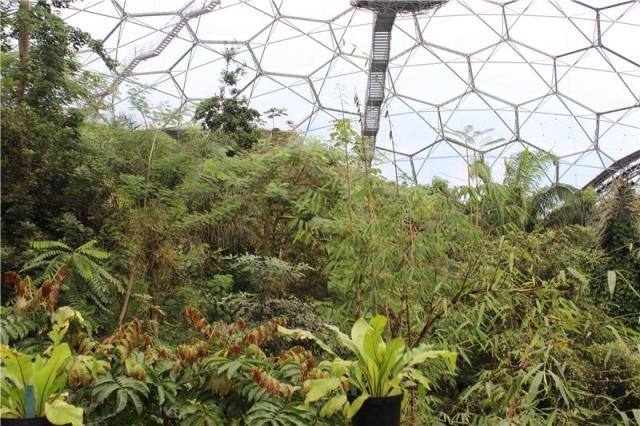Feb 28 2015
Scientists from the University of the West of England (UWE Bristol) believe that the bird’s nest fern, a plant commonly found in many of our homes, has a critical place in maintaining the biodiversity and the ecosystems of the world’s rainforests.
 Eden
Eden
The scientists are dividing their time between the rainforests of Borneo and the ‘natural laboratory’ of the rainforest biome at the Eden Project in Cornwall.
Dr Farnon Ellwood is leading the study, he explains, “In its natural habitat the bird’s nest fern grows on trees high up in the rainforest canopy where it can reach enormous sizes of up to 180 kg’s with leaves stretching two metres in diameter.
“Bird’s nest ferns are epiphytes meaning that, by definition, the plants rely on trees purely for support, taking no nutrients from their host in the way a parasitic plant would. The ferns form a rosette of leaves, allowing them to catch rainfall, falling leaves and other debris. These ‘canopy composters’ provide homes for micro-organisms and invertebrate animals such as earthworms and insects.”
The UWE Bristol scientists believe that these epiphytic ferns are crucial to the maintenance of the rainforest, contributing not just nutrients but a unique habitat, and that without these plants the world’s rainforests would change radically.
Working from the controlled environment of the Eden Project’s tropical biome, Dr Farnon Ellwood and PhD researcher Julian Donald are designing a series of experiments that will eventually be ready for transfer to the rainforests of Borneo.
Dr Ellwood continues, “Borneo’s rainforest may be our outdoor laboratory, but the Eden Project is our indoor laboratory. We know the precise constituents of the soil; if we want it to start raining we switch on the irrigation, if we want it to stop raining we switch off the irrigation. If we need to increase biodiversity we add animals to our experiments, if we want to simulate the effects of local extinctions we can exclude animals from our experiments. By working on a model system in a model rainforest we are able to focus on developing our ideas, our techniques and our methodology in a precise and very controlled manner before performing the experiments in deepest darkest Borneo.
“Birds nest ferns are islands in a sea of canopy: they produce compost and recycle important nutrients from the trees to the forest floor; they create habitats for millions of insects and countless micro-organisms. Many of the insects, having never been seen, will certainly be new to science.
With climate change and habitat destruction changing the face of the planet this research will show how the nature of rainforests will change in the future under climate change and environmental disturbance.
“Our world’s biodiversity is involved in a fateful game of ecological Jenga. In the game you remove blocks of wood from a tower, never knowing when it will come crashing down. Just as in the game, we have no idea how the planet’s biodiversity and the ecosystems it supports will react to the continued removal of species, which is taking place on a daily basis.
“If epiphytic habitats such as bird’s nest ferns were removed from the rainforest, or if the ecosystems contained within them fail, there is a real possibility that the entire rainforest ecosystem could collapse, or at least change radically. We are in a race against time to understand and ameliorate these consequences, which is why we are performing novel and highly ambitious experiments in the controlled environment of the Eden Project, before scaling up our experiments on biodiversity and extinctions in a real rainforest.”
A key question that the scientists aim to answer is which species play the most important role in the functioning of ecosystems, and what would happen if those species were to go extinct.
Dr Ellwood concludes, “What we are here to do is to try to unravel this complex process and to see which species play the most important roles and which species play lesser roles. It may be that, given current rates of extinctions and ecosystem collapse, we may have to choose which species to save and which to let go.
“We know that epiphytes play a major role in rainforest canopies. They provide homes for animals, they provide nutrients; rainfall filters through the epiphytes and takes those nutrients down to the ground. We know our climate is changing and we can change the climate within the epiphytes. We also know that the animals within the epiphytes play a critical role and that these species are going extinct. We can experimentally cause species extinctions in the epiphytes. By performing these sorts of manipulative experiments on the small worlds inside ferns, we can gain an insight into the fate of our own world as it continues to be modified by humans.”